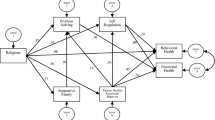Abstract
Studies have demonstrated the positive impacts of both parent and adolescent religiosity on adolescent outcomes; however, the relationships among these variable have not been studied. Our study was conducted to assess whether adolescent religiosity mediates the relationship between parent religiosity and adolescent emotional and behavioral health outcomes. A sample of 491 late adolescents ages 18–22 completed surveys that assessed their parents’ religious practices, their own religious practices, deviant behaviors, and internalizing behaviors. Findings suggest that adolescent religiosity mediates the relationship between parents’ religiosity and adolescent health outcomes such as drug and alcohol use and depression.
Similar content being viewed by others
References
Baron, R. M., & Kenny, D. A. (1986). Moderator-mediator variable distinction in social psychological research: Conceptual, strategic, and statistical considerations. Journal of Personality and Social Psychology, 51, 1173–1182.
Bergin, A. E., Stinchfield, R. D., Gaskin, T. A., Masters, K. S., & Sullivan, C. E. (1988). Religious life-styles and mental health: An exploratory study. Journal of Counseling Psychology, 35, 91–98.
Blakeney, R. F., & Blakeney, C. D. (2006). Delinquency: A quest for moral and spiritual integrity? In E. C. Roehlkepartain, P. E. King, L. Wagner, & P. L. Benson (Eds.), The handbook of spiritual development in childhood and adolescence (pp. 371–383). Thousand Oaks, CA: Sage.
Boyatzis, C. J., Dollahite, D. C., & Marks, L. D. (2006). The family as a context for religious and spiritual development in children and youth. In E. C. Roehlkepartain, P. E. King, L. Wagener, & P. L. Benson (Eds.), The handbook of spiritual development in childhood and adolescence (pp. 297–309). Thousand Oaks, CA: Sage.
Capaldi, D. M., Stoolmiller, M., Clark, S., & Owen, L. D. (2002). Heterosexual risk behaviors in at-risk young men from early adolescence to young adulthood: Prevalence, prediction, and association with STD contraction. Developmental Psychology, 38, 394–406.
Cotton, S., Zebracki, K., Rosenthal, S. L., Tsevat, J., & Drotar, D. (2006). Religion/spirituality and adolescent health outcomes: A review. Journal of Adolescent Health, 38, 472–480.
Doherty, W. J. (1999). Morality and spirituality in therapy. In F. Walsh (Ed.), Spiritual resources in family therapy (pp. 179–193). New York: Guilford Press.
Doherty, W. J. (2003). A wake up call: A comment on “lived religion and family therapy”. Family Process, 42, 181–183.
Erikson, E. H. (1968). Identity, youth, and crisis. New York: Norton.
Flor, D. L., & Knapp, N. F. (2001). Transmission and transaction: Predicting adolescents’ internalization of parental religious values. Journal of Family Psychology, 15, 627–645.
Forliti, J. E., & Benson, P. L. (1986). Young adolescents: A national study. Religious Education, 81, 199–224.
Fowler, J. W. (1991). Stages in faith consciousness. New Directions for Child Development, 52, 27–45.
Fowler, J. W., & Dell, M. L. (2006). Stages of faith from infancy through adolescence: Reflections of three decades of faith development theory. In E. C. Roehlkepartain, P. E. King, L. Wagner, & P. L. Benson (Eds.), The handbook of spiritual development in childhood and adolescence (pp. 34–45). Thousand Oaks, CA: Sage.
King, P. E., & Benson, P. L. (2006). Spiritual development and adolescent well-being and thriving. In E. C. Roehlkepartain, P. E. King, L. Wagner, & P. L. Benson (Eds.), The handbook of spiritual development in childhood and adolescence (pp. 384–398). Thousand Oaks, CA: Sage.
Lawrence, J. A., & Valsiner, J. (1993). Conceptual roots of internalization: From transmission to transformation. Human Development, 36, 150–167.
Merrill, R. M., Salazar, R. D., & Gardner, N. W. (2001). Relationship between family religiosity and drug use behavior among youth. Social Behavior and Personality, 29, 347–358.
Ruiz, S. Y., Roosa, M. W., & Gonzales, N. A. (2002). Predictors of self-esteem for Mexican American and European American youths: A reexamination of the influence of parenting. Journal of Family Psychology, 16, 70–80.
Snider, J. B., Clements, A., & Vazsonyi, A. T. (2004). Late adolescent perceptions of parent religiosity and parenting processes. Family Process, 43, 489–502.
Vazsonyi, A. T., Pickering, L. E., Junger, M., & Hessing, D. (2001). An empirical test of a general theory of crime: A four-nation comparative study of self-control and the prediction of deviance. Journal of Research in Crime and Delinquency, 38, 91–131.
Wallace, J. M., & Williams, D. R. (1999). Religion and adolescent health-compromising behavior. In J. Schulenberg, J. L. Maggs, & K. Hurrellman (Eds.), Health risks and developmental transitions during adolescence (pp. 444–468). New York: The Guilford Press.
Weinberger, D. A., & Schwartz, G. E. (1990). Distress and restraint as superordinate dimensions of self-reported adjustment: A typological perspective. Journal of Personality, 58, 381–417.
Wendel, R. (2003). Lived religion and family therapy: What does spirituality have to do with it? Family Process, 42, 165–179.
Whitbeck, L. B., Yoder, K. A., Hoyt, D. R., & Conger, R. D. (1999). Early adolescent sexual activity: A developmental study. Journal of Marriage and the Family, 61, 934–946.
Author information
Authors and Affiliations
Corresponding author
Rights and permissions
About this article
Cite this article
Barton, A.L., Snider, J.B., Vazsonyi, A.T. et al. Adolescent Religiosity as a Mediator of the Relationship Between Parental Religiosity and Adolescent Health Outcomes. J Relig Health 53, 86–94 (2014). https://doi.org/10.1007/s10943-012-9596-7
Published:
Issue Date:
DOI: https://doi.org/10.1007/s10943-012-9596-7




